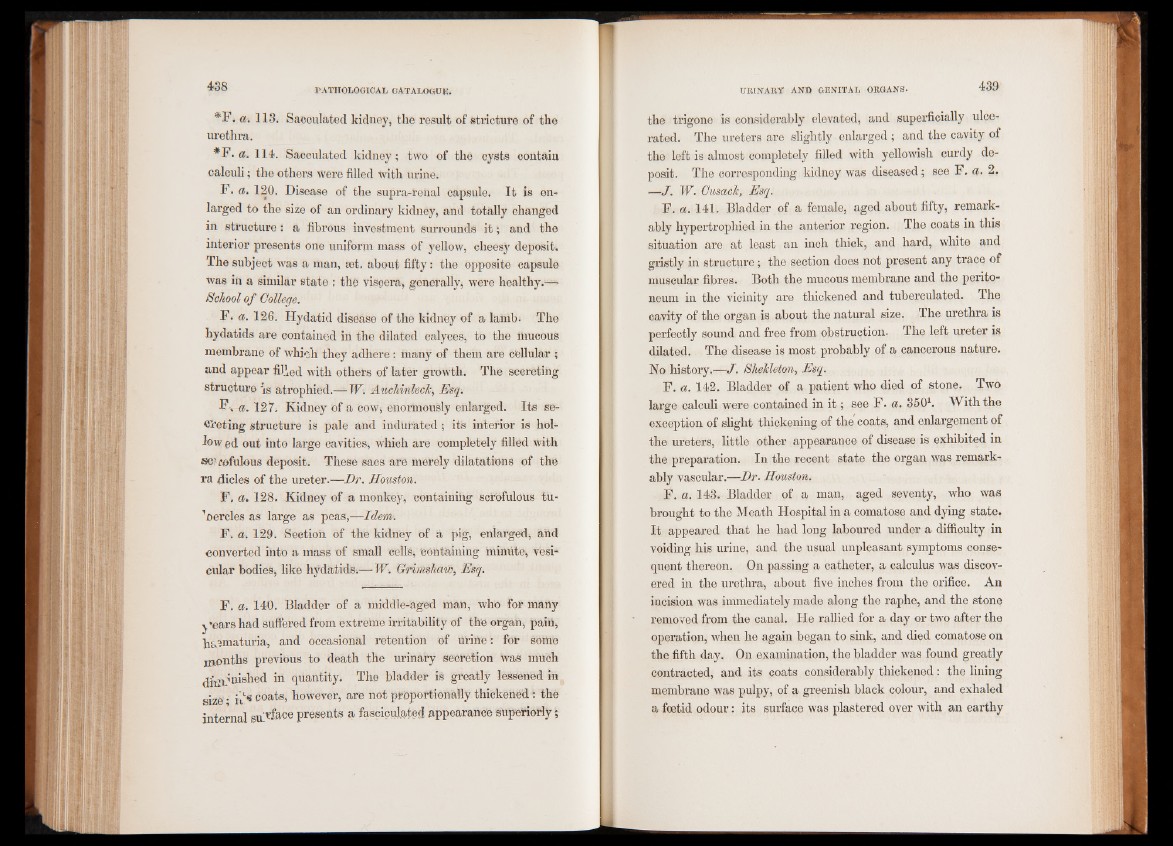
*F .a. 113. Sacculated kidney, the result of stricture of the
urethra.
*F. a. 114. Sacculated kidney; two of the cysts contain
calculi ; the others were filled With urine.
F . a. 120. Disease of the supra-renal capsule. It is enlarged
to the size of an ordinary kidney, and totally changed
in structure : a fibrous investment surrounds it ; and the
interior presents one uniform mass of yellow, cheesy deposit.
The subject was a man, set, about fifty : the opposite capsule
was in a similar state ; the visgera, generally, were healthy.—
School of College.
F. a. 126. Hydatid disease of the kidney of a lamb. The
hydatids are contained in the dilated calyces, to the üiucous
membrane of which they adhere : many of them are cellular ;
and appear filled with others of later growth. The secreting
structure Is atrophied.— W. AuchinlecJc, Esq.
F, a. 127. Kidney of a cow* enormously enlarged. Its se-
Ci’eting structure is pale and indurated ; its interior is hollow
ed out into large cavities, which are completely filled with
sc? rofulous deposit. These sacs are merely dilatations of the
ra dicles of the ureter.—Dr. Houston.
F. ch 128. Kidney of a monkey, containihg scrofulous t'u-
’oercles as large as peas,-—Idemi
F . a. 129. Section of the kidney of a pig, enlarged, and
converted into a mass of small cells, containing minute, vesicular
bodies, like hydatids-.— W. Grimskaw, Esq.
F. a. 140. Bladder of a middle-aged man, who For many
v ‘ears had suffered from extreme irritability of the organ, pain,
hematuria, and occasional retention of Urine:: for sottie
months previous to death the urinary sécrétion Was much
Ajm.mished in quantity. The bladder is greatly lessened in
size * n* coats, however, are not proportionally thickened : the
internal su'.vface presents a fasciculated appearance superiorly ;
the trigone is considerably elevated, and superficially ulcerated.
The ureters are slightly enlarged; and the cavity of
the left is almost completely filled with yellowish curdy deposit.
The corresponding kidney was diseased; see F. a. 2.
—J. W. CusacJc, Esq.
F. a. 141. Bladder of a female, aged about fifty, remarkably
hypertrophied in the anterior region. The coats in this
situation are at least an inch thick, and hard, white and
gristly in structure; the section does not present any trace of
muscular fibres. Both the mucous membrane and the peritoneum
in the vicinity are thickened and tuberculated. The
cavity of the organ is about the natural size. The urethra is
perfectly sound and free from obstruction. The left ureter is
dilated. The disease is most probably of a cancerous nature.
No history.—J. BheJcleton, Esq.
F. a. 142. Bladder of a patient who died of stone. Two
large calculi were contained in it ; see F. a. 3501. With the
exception of slight thickening of the coats, and enlargement of
the ureters, little other appearance of disease is exhibited in
the preparation. In the recent state the organ was remarkably
vascular.—Dr. Houston.
F. a. 143. Bladder of a man, aged seventy, who was
brought to the Meath Hospital in a comatose and dying state.
It appeared that he had long laboured under a difficulty in
voiding his urine, and the usual unpleasant symptoms consequent
thereon. On passing a catheter, a calculus was discovered
in the urethra, about five inches from the orifice. An
incision was immediately made along the raphe, and the stone
removed from the canal. He rallied for a day or two after the
operation, when he again began to sink, and died comatose on
the fifth day. On examination, the bladder was found greatly
contracted, and its coats considerably thickened: the lining
membrane was pulpy, of a greenish black colour, and exhaled
a foetid odour: its surface was plastered over with an earthy